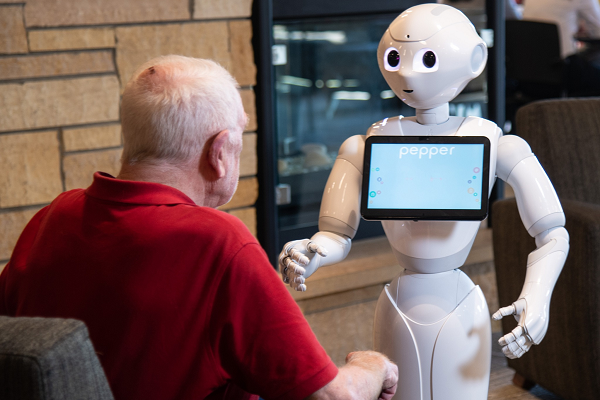Minnesota Nursing Homes Introduces Robot Caregivers
 A Minnesota nursing home has begun using two AI-powered robots as care assistants for those with dementia or early-stage Alzheimer’s. The Pepper and NAO robots, both built by Softbank, were customized by roboticists at the University of Minnesota, Duluth to interact and enhance the independence of residents at The Estates of Roseville, followed by another seven nursing homes.
A Minnesota nursing home has begun using two AI-powered robots as care assistants for those with dementia or early-stage Alzheimer’s. The Pepper and NAO robots, both built by Softbank, were customized by roboticists at the University of Minnesota, Duluth to interact and enhance the independence of residents at The Estates of Roseville, followed by another seven nursing homes.
Pepper and NAO
The four-foot-tall Pepper and two-foot-tall NAO are set to engage with patients through conversation and observation. The human-shaped robots can measure facial expressions, body language, and vocal tones while adjusting their own faces and voices to simulate human interaction. The robots are programmed to remind residents to exercise and eat, leading them in dance and telling jokes. They will watch for changing habits of residents and even use “cognitive therapy” to encourage mental acuity.
UMD professor of computer science Arshia Khan and her graduate students customized Pepper and NAO for the nursing home, which is run by Monarch Healthcare Management. They’ve begun training the robots to learn the facility floor plans so that Pepper and NAO can travel independently upon their duties.
“I am extremely excited to be making history with my students by deploying humanoid robots in nursing homes to help care for our elderly,” Khan said. “This is a major step and the beginning in helping improve the quality of life of elderly and people affected with dementia using humanoid robots.” This robot deployment will be the first in the United States focused on augment care for residents in nursing homes.
Pepper Pop
Softbank began manufacturing Pepper back in 2014, but paused production last year, having only made 27,000. This kind of use case might spark a revival, however. Using robots for healthcare is steadily growing in popularity, albeit with a wide range of bodies and AI tools. For instance, there’s the scooter mixed with a tablet computer named temi, which follows owners about the home, and the cat-faced Mylo from CR Robotics, designed to be a friendly, comforting image for people with Alzheimer’s to interact with on a daily basis. For a more explicitly humanoid robot, Singularity Studio and Hanson Robotics created Grace, which looks like the head and upper torso of a woman and can converse with users about a range of subjects, particularly physical and mental health. And the New York State Office for the Aging (NYSOFA). recently gave out free ElliQ robot companions from Intuition Robotics to 800 older adults living independently.
“Humanoid robots in helping elderly is the way to move ahead in caring for our elderly,” Khan said. “The growth in elderly population and simultaneous growth in the people affected with dementia, staff shortages and lack of people who can for our elderly is a problem that is growing exponentially. If we don’t look for alternative solutions and think outside the box our elders will suffer. Japan is way ahead of us and it’s time we in the US caught up.”
Follow @voicebotai Follow @erichschwartz
NY State Gives More Than 800 ElliQ Robot Companions for Elderly
Awakening Health Launches Humanoid Robot Healthcare Assistant Named Grace








